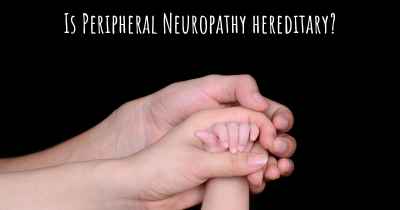4
How is Peripheral Neuropathy diagnosed?
See how Peripheral Neuropathy is diagnosed. Which specialists are essential to meet, what tests are needed and other useful information for the diagnosis of Peripheral Neuropathy

Peripheral neuropathy is a condition that affects the peripheral nerves, which are responsible for transmitting signals between the central nervous system and the rest of the body. It can cause a wide range of symptoms, including numbness, tingling, weakness, and pain in the affected areas. Diagnosing peripheral neuropathy involves a combination of medical history, physical examination, and various tests.
Medical History:
The first step in diagnosing peripheral neuropathy is to gather a detailed medical history from the patient. The healthcare provider will ask about the patient's symptoms, their duration, and any factors that may have contributed to the development of neuropathy. This may include questions about family history, exposure to toxins or certain medications, history of diabetes or other chronic diseases, and any recent infections or injuries.
Physical Examination:
After obtaining the medical history, a physical examination is conducted to assess the patient's neurological function. The healthcare provider will evaluate muscle strength, reflexes, coordination, and sensation in the affected areas. They may also check for any visible signs of nerve damage, such as muscle wasting or changes in skin color or texture.
Neurological Tests:
To further evaluate the extent and nature of peripheral neuropathy, several neurological tests may be performed. These tests help determine the specific nerves that are affected and the severity of the condition. Some commonly used tests include:
1. Nerve Conduction Studies (NCS): This test measures the speed and strength of electrical signals as they travel through the nerves. Small electrodes are placed on the skin, and a mild electrical impulse is applied to stimulate the nerves. The response is recorded, and the results can help identify any abnormalities in nerve function.
2. Electromyography (EMG): EMG measures the electrical activity of muscles. A thin needle electrode is inserted into the muscle, and the patient is asked to contract the muscle. The electrical signals generated by the muscle are recorded and analyzed. EMG can help determine if muscle weakness or atrophy is due to nerve damage.
3. Skin Biopsy: In some cases, a small sample of skin may be taken for examination under a microscope. This can help identify any abnormalities in the small nerve fibers responsible for sensation. Skin biopsy is particularly useful in diagnosing small fiber neuropathy, which may not be detected by other tests.
4. Autonomic Testing: Autonomic nerves control involuntary functions such as heart rate, blood pressure, and digestion. Autonomic testing involves various procedures to assess the function of these nerves. This may include measuring heart rate variability, evaluating sweat production, or monitoring blood pressure changes in response to certain stimuli.
Blood Tests:
Blood tests are often performed to identify any underlying medical conditions that may be causing or contributing to peripheral neuropathy. These tests can help detect abnormalities such as vitamin deficiencies, autoimmune disorders, infections, or metabolic disorders like diabetes. Additionally, blood tests may be used to check for specific antibodies or genetic markers associated with certain types of neuropathy.
Imaging Studies:
In some cases, imaging studies may be ordered to rule out other potential causes of neuropathy or to identify structural abnormalities. Magnetic Resonance Imaging (MRI) or Computed Tomography (CT) scans can provide detailed images of the brain, spinal cord, and other structures, helping to identify any tumors, herniated discs, or other abnormalities that may be compressing or damaging the nerves.
Other Specialized Tests:
Depending on the suspected cause of peripheral neuropathy, additional specialized tests may be necessary. For example, if an autoimmune disorder is suspected, a nerve or muscle biopsy may be performed to examine the tissue for signs of inflammation or damage. Genetic testing may also be recommended in certain cases to identify inherited forms of neuropathy.
Conclusion:
Diagnosing peripheral neuropathy involves a comprehensive approach that combines medical history, physical examination, and various tests. The goal is to identify the underlying cause, determine the specific nerves affected, and assess the severity of the condition. This information is crucial for developing an appropriate treatment plan and managing the symptoms effectively.
Diseasemaps
nerve induction test
health history
tilt table test
neurologists are among the best candidates for diagnosing PN
health history
tilt table test
neurologists are among the best candidates for diagnosing PN
Posted Dec 1, 2019 by viva.dana 2500








